by B.B. Pelletier
This series began with the earliest sights that were both primitive and simplistic. Then, we looked at the evolution of peep sights, starting back before 1840 and progressing to around 1903.
There’s a lot more to be said about both open and peep sights. It was at this point in time that they each began to develop along separate lines. I think I need to concentrate on one type of sight per report to keep things straight. In today’s report, I’ll look at open sights from around the middle of the 19th century until today.
Open sights evolved rapidly after the American Civil War, which ended in 1865. Not that all the innovation was done in the U.S., mind you, but that was a time when the world of firearms was advancing though technological stages, and the sights kept pace with everything. Other wars around the world at the same time drove the armies of many nations to push the limits of firearms; and we got smokeless gunpowder, fixed cartridges, breechloading arms and eventually repeating firearms from this era.
In 1850, a military firearm was loaded at the muzzle and carried but one shot. Repeaters at this time were novelties and even dangerous experiments because of the volatility of black powder. These single-shot martial arms were accurate to about 400 yards on man-sized targets.
In 1900, there were repeating firearms holding 10 self-contained cartridges filled with smokeless powder and spitzer (pointed) bullets that could shoot accurately to more than one mile distance. Most of the primary designs we use today had been invented.
I stopped discussing open sights when I started my look at peep sights; but even though the advances in open sights were not as great in terms of the improvements they contributed to accuracy, open sights did advance in parallel with peep sights.
Range-driven improvements
The old black powder arms were accurate; but because they shot their bullets so slowly, the trajectories were huge. Bullets dropped by many feet on their way to the target. We all like watching Matthew Quigley shoot his big Sharps rifle at distant targets, but how many people appreciate that his bullets are dropping by 60-80 FEET before they impact the target?
Enough fantasy. Let’s get real for a moment. In 1874, the U.S. and Irish rifle teams shot a match at the Creedmoor range on Long Island to decide which nation had the world champion marksmen. They shot at targets at 800, 900 and 1,000 yards. At 1,000 yards, the bullets from the Americans’ .45-caliber rifles dropped more than 100 feet. So, they had to set their sights to compensate for this tremendous drop. A 550-grain .45-caliber lead bullet starting out at 1,400 f.p.s. will drop 114.69 feet when it gets to 1,000 yards.
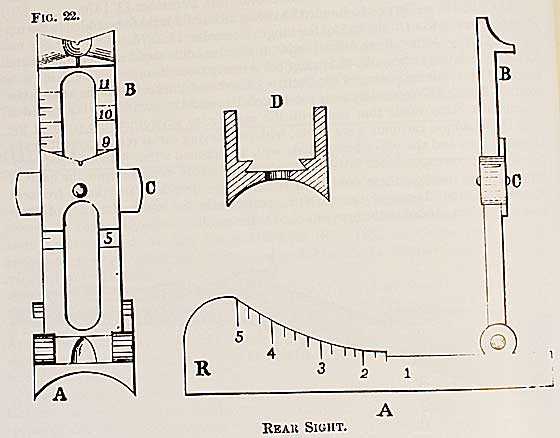
This model 1873 Springfield Trapdoor carbine rear sight (from 1878) is graduated to 500 yards on the ramp and to 1,100 yards on the upright standard. There’s another sight at the top of the standard that’s sighted even farther — perhaps 1,300 yards. Image copied from Trapdoor Springfield by M.D. (Bud) White and B.D. Ernst, copyright 1980, Beinfeld Publishing, Inc.
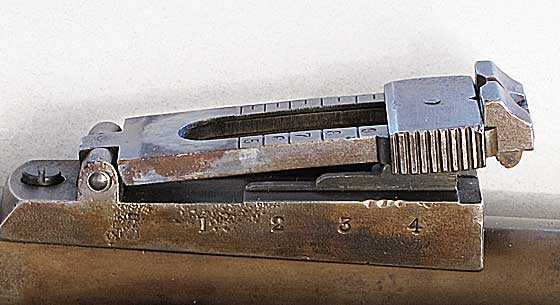
This 1879 Remington rolling block rear sight on an Argentine military rifle chambered for .43 Spanish (11.15 x 58R) is elevated to shoot 400 yards. By flipping the standard straight up, the rifle can shoot out to 900 yards accurately.
I mention this because airgunners everywhere are so willing to condemn the .22-caliber pellet for having a “rainbow trajectory.” Folks, they don’t know the meaning of that term! And this is the reason that I refuse to give up my fascination for firearms — because I often find remarkable parallels between them and airguns. But some shooters will watch Quigley and then opt for the fastest .177 they can buy, so their pellets don’t drop too much at long range! To heck with that! Instead, take the time to learn where the pellets will drop and shoot the more accurate, heavier pellets. That’s what Quigley did.
So, the military rear sights of the 1870s were long affairs that had inclined ramps to raise them up for long-range shots. By 1900, this had been taken to the absurd limits of 2,000-yards. Nobody could see that far on the battlefield to shoot accurately; but by this time, military leaders were espousing area fire and talked about “beaten zones” and “cones of fire.” They were thinking of rifle bullets in a way similar to artillery shells, except they didn’t explode, of course.

By the turn of the 20th century, military leaders were thinking in terms of 2,000 yards and indirect plunging fire, as this 1896 Mauser rear sight shows. Image copied from Mauser Bolt Rifle, Third Edition by Ludwig Olson, copyright 1976, E. Brownell & Son.
By the time World War I started, the theory of indirect rifle fire was at its height, though it was proven ineffective through actual battlefield experience. Soldiers were also trained to shoot at targets directly, which ended up being the direction that proved the most effective. But the theory did not die. It persisted until the start of World War II, and the weapons that were used continued to have rear sights that adjusted for 2,000-yard fire.
Countries were also experimenting with ammunition at this same time (1898-1915). As each new innovation hit the field, nations scrambled to adapt their weapons to more modern designs that shot farther and flatter. As a result of what they learned, the rear sights also changed to reflect the flatter trajectories.
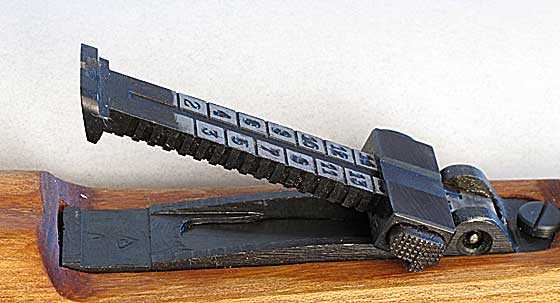
This model 1898 Mauser rear sight has been updated to reflect the more streamlined 8mm ammunition used during World War II. It’s shown elevated for 2,000 yards, but looks just a little higher than the rolling block rear sight of 1879 that’s set for 400 yards.
Of course, civilian arms kept pace with the military weapons in every way. Once the wars were over, the sights on civilian arms gained the same innovations that served the military so well; because they were sold to individuals instead of governments, they had to be more practical. No shooters wanted sights that were good for 2,000 yards — no matter what their military experience had been. So, the rear sights still elevated, but this time to more reasonable yardages.
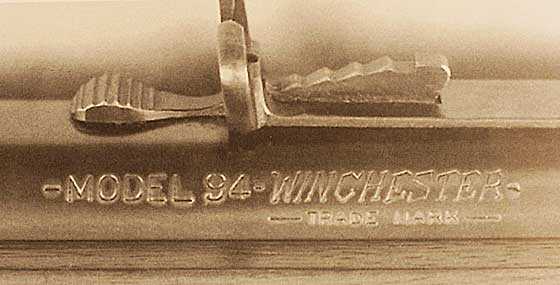
This Winchester model 94 rear sight is probably good out to 200 yards, or so (for the 30-30 round). Photo copied from Winchester Model 94 by Robert C. Renneberg, copyright 2009, Krause Publications, Inc.
And I would be remiss if I didn’t mention the express sights that were popularized by African hunters from the 1870s through the 1920s. These are sights that flip up and are regulated for a single cartridge at a single range. The most common that I have seen are those for 100, 200 and 300 yards — but there are many other combinations.
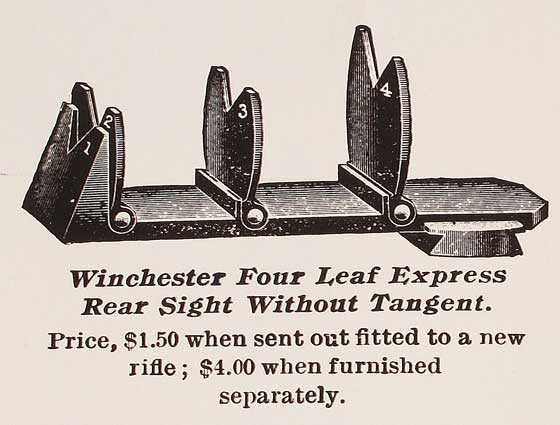
Winchester express rear sight has three flip-up blades for distances to 400 yards. Image copied from Winchester — An American Legend by R.L. Wilson, copyright 1991 by R.L.Wilson. Published in U.S.A. by Random House.
The express sight is a special adaptation of the earlier leaf rear sight that has two distances built in. Those go back as far as the 1850s. I showed you one on my 1867 gallery dart gun.

This rear sight from a gallery dart gun of 1867 could have been the inspiration for the express sights.
Well, that’s it for this time. There’s much more to say about open sights — mainly on the civilian side. We need to look at them, because airgun sights are directly related.
We’ll also look further at peep sights because we haven’t exhausted them, either. This series has at least a couple more parts to come.
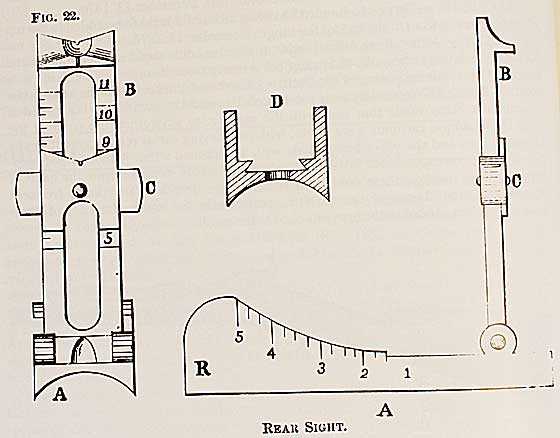
I can’t imagine the stresses of standing a mile off from the enemy and having to worry about having one out of a hail of bullets raining in on you having your name on it. No wonder trenches were developed!
/Dave
/Dave,
That was what the generals thought, as well. The problem was, it didn’t seem to work that way. I guess it was just too indefinite, and there was no way to get a body count. Wars are won by numbers, too.
B.B.
This reader sent a question to the wrong address. I have posted it here for him and answered it below.
Hello I bought rws 350 magnum .177 and I need some help. Please guide me. What weight of pellets should I use for pest control like rabbits ets..
Talha
Talha,
I would suggest trying the Beeman Kodiak pellet and the JSB Exact domed pellet that weighs 10.2 grains. These should do well in a Diana 350 Magnum.
Would any readers like to add their opinions?
B.B.
I don’t have a Diana 350 in .177 but I do have a similar powered gun: the Russian Bakail m513 in .177 that operates in the same power range , but has a much more violent firing behavior. I have hunted with it and have even shot some feral chickens that weighed in at around 8-10 lbs live . With that gun I ASSUMED the heavier 10.5 gr pellets(I used Kodiaks and CPH) would be more accurate and better for hunting. I found that the lighter 7.9 grain premiers were more accurate and dispatched the game just as well. I have found that with a 11-20 ft/lb.177 cal springer air rifle that the doomed pellet will almost ALWAYS pass through a small game animal . It doesn’t matter what wt pellet you shoot, just shoot the one that shoots best in your gun in your hands. If you want a pellet that will not pass through in .177 cal , then use a wad cutter or predator pellet. That is, IF you can get them to shoot accurately in your gun . That means nothing more than 1″ groups at 25 yards. If you want a springer air rifle that will not over penetrate the target with the more accurate doomed pellets, go up in caliber. A .22 or .25 cal springer air rifle shooting at 12-16 ft/lbs is a better rig for hunting small game than a more powerful gun in .177 ,unless you want to go PCP which I will not comment on as I have zero experience with them.
Spelling error above. That would be “domed pellets not doomed… to much in a hurry today ,off to pound nails again, and modify some residental wreckage.
In my experience, the key to using a .177 Cal. air rifle for effectiveness in hunting situations is shot placement. This being head shots.
Mike
Talha,
I’m with Robert. Use the pellet that is most accurate in your gun in your hands at the distances you’ll be shooting rabbits.
Learn the rabbits anatomy and know where to place your shot. Rather than shoot at ranges beyond those that you are consistently accurate learn how to stalk your prey. Good luck.
kevin
Talha,
my RWS 350 does very well with RWS Super H (hollowpoint) pellets. At the muzzle, the velocity the rifle shoots them at is in the 17 ft. lb. range, more than adequate for small vermin.
Fred DPRoNJ
Looks like a slow start today, so let me throw in some confusion…..
O.K.
I have six different rifles all shooting single digit chrono strings ( E.S. for 10 shots). Most of them have been tried from a “cold start”….no warmups. Pellets straight from the box or tin.
Some of the rifles had been sitting for weeks without being fired.
Four of them have Vortek kits, the other two are stock power plants and have never been opened up.
With all but one or two I got the max FPE out of the pellets thay had the tightest E.S. .
I also had half or better have tight E.S. with two kinds of pellets of considerably different weights.
One of them was spitting out two kinds of pellets that had considerably different weights at the same FPE.
twotalon
twotalon,
This sound reasonable to me. I think the pellets that are giving a looser spread are erring further on the lower side with the pellets on the higher side limited by the max of the rifle’s power plant. That would bring the average velocity down and with it, the fpe.
/Dave
Yup. And when the power level drops off very much, the vibration gets nasty.
twotalon
Another good one…
One rifle was kicking out some pretty wide velocity spreads with pellets that had previously worked good.
Changed the breech seal, and the average velocity tightend way up and at the same time went down a few fps.
Not expected, but happened. This rifle does not seem to conform to all of the rules established by the other five.
For future protection, I placed a small nylon washer in the breech so the compression chamber is not always smashing the seal (underlever).
twotalon
skritch, skritch…. This rifle is a rebellious one. Lock it in a dark closet for a while…
/Dave
Pete Z & Kenholmz,
My prayers and those of so many others go out to both of you for successful surgeries and full recoveries. You’re such an integral and important part of the blog, so even a short absence will be felt.
Know that your friends on the blog will be waiting to hear from you. Whenever you feel well enough to participate, again, come back to the bosom of your airgunning family.
Edith
That’s right. Best wishes you guys and we’ll look for you back on the blog. By the way, anyone know what happened to Wulfraed? He had an inexhaustible fund of information on just about everything. I thought that he was just going offline while he moved to Michigan.
Matt61
I second the sentiment, I hope all goes well with the surgeries, and I hope Wulfraed is OK, safe, warm, dry, fed, all the essentials.
Thank you, Edith. I appreciate you well wishes very much.
Ken
What Edith said.
twotalon
I’ll second again what Edith said, Ken and Pete. And to anyone else that has these things happening that they may not want to talk about.
/Dave
PeteZ & KenHo,
When “The Leader of the Pack”, Ms. Edith sez it, ya best be doin’ it! Get better & get back here. No whinin’ & No snivelin’. Thoughts & prayers, guys.
Beaz
Pete Z & Kenholmz,
Best wishes for a speedy recovery. Get back here soon.
kevin
This seems appropriate:
http://www.bklyn-genealogy-info.com/Society/Creedmoor.html
kevin
Pete Z & Kenholmz,
My prayers and best wishes are with you both for successful surgeries and speedy recoveries.
Bruce
My support and prayers go out to both Ken and Pete. BB set a pretty tough example for us guys.
Matthew Quigley is my hero! Even my cat Pender likes to watch his movie.
We lost our old dog Tasha this morning. She had gotten sick over the past weekend, and the vet could not find the cause. She was mostly my wife’s dog, and she is heartbroken. We had her for ten years.
The little cat in my avatar is Pender. He will be three on Monday, and isn’t so little any more. He is my constant companion, he is on the back of the couch 2″ from my head as I type this.
We still have our 10 year old white cat Yettisue, and our little 2 year old rat terrier Strawberry.
They are from New Albany and Myrtle Mississippi, respectively. Tasha was from Blue Mt. MS.
Pender was born 15 miles north of the Mexican border in the Gadsden Purchase of New Mexico.
That is what happens when your job takes you around the country.
Nice article today on open sights. I’m going to have to take a closer look at the sight on my .45-70.
Les
Les,
I’m sorry to hear of your loss. I breaks my heart to lose a pet and companion of many years and I know how long the hurt can last. It’s the hardest part of having pets.
B.B.
Thanks, BB.
The gun is an 1873 model Springfield trapdoor rifle.
It was my grandfather’s gun. Been handed down through the generations.
Les
Les,
I removed my question because after reading it, it looked crass in a condolence message. I’m sorry. I didn’t mean to trivialize Tasha’s passing.
B.B.
Oh, you didn’t need to do that. I didn’t find your comment offensive at all.
Life goes on.
Les
I was intrigued to see in Heaven is for Real and Akiane Kramarik’s visions that there are animals in heaven. I like that idea.
Matt61
Les,
So sorry to hear about your dog. It never gets easier does it.
kevin
Les,
My condolences on the loss of your dog. I know how big a hole it can leave.
Edith
Thanks, Edith and Kevin, BB and Matt.
I think God saves the ones we love for us.
Les
My condolences to you and yours, Les. Having dogs as family members all of my life, I know how big of a hole there is when they have to go on without us…
/Dave
Desertdweller,
I sat on the floor with Bullet, a sheppard and lab cross, and held him while he died. Saying good by to a furry family member is never easy.
Bruce
Dave, Bruce,
Thanks for the condolences. Rene’ and I each had a dog and a cat that had attached themselves to us.
Now she says, “No more pets”.
I can’t blame her for feeling that way, but I’m glad we still have the three left. Tasha was her dog.
Les
I can imagine how you felt when Bullet died. I spent about four hours with Toni her last night. Twice I had to go into the house and twice she raised her head and barked for me to not leave her. When I decided I must go in to get some rest for work she lay quietly, but breathing rapidly and shallowly. I didn’t expect her to live the night. Early next morning I go up and went immediately out to see her. She was still alive. I caressed her. She opened and closed her mouth four times then she was still. I caressed her and watched her breathing and I saw when she breathed her last breath. It was hard to leave her to go to work. I just caressed her for a while. Then I placed her in a large cardboard box and in a place out of the sun. When I got home I got my pick axe and began digging a proper grave for her. It was our drought that left me needing the pick axe and I was grateful that I had it. We have been here for 23 years. There are four dogs and seven cats buried on this property. There will likely be more before we are done. I love them all.
I expect it is much the same for you.
Ken
Desertdweller, I too am sorry to hear of your loss of Tasha. If I can say only one thing about such loss it is that we grieve because of the bonding. We grieve because together we have created something of great value, something of infinite value. I like to tell everyone about “The Little Prince” because I love this story. When the Little Prince meets the fox, the fox tell him that he musn’t try to rush things. The fox says, “To me you are just a little boy, like a hundred thousand other little boys and I have no use of you. To you I am just a fox, like a hundred thousand other foxes. But if you tame me then we shall need each other. Then to me you will be unique in all the world and to you I shall be unique in all the world”.
Yettisue, Strawberry, and you little Pender must all be unique to you. Your Pender look like our Mama Bear and her daughter Scampi Bear (Scampi for short). You might guess that Mama Bear’s son, Panda, looks a bit different.
When I was much younger I had two dogs that were taken away from me. Shela was taken because she was a female and we were poor and lived in town. She had a litter of puppies and not long after my parents called the city workers to come get her. Sadly, I was told to call Shela to come out from under the house. I did so; it was my first act of betrayal and I hurt whenever I think of that moment. I think I was seven then. When I was 14 Blacky was taken from me. Sadly, Blacky bonded with me and only me. I didn’t know why my parents said they thought he was a Chow at the time. He was considered a threat to others although he was not particularly large. They took him and I never saw him again. Fast forward to 1980. I was 29 and my beloved Sentry was 4. We went out of town for a few days. Upon returning I was informed Sentry had gotten out of the back yard and had been struck by a car and killed. He had been taken to be disposed of. And I never saw him again. I ache because I can’t have any closure; I can’t fill the void. There is a space that belongs to these and nothing can fill that space. I have loved and lost others since 1980 but I have been able to be with them, to hold them and comfort them. It isn’t really closure, but it is something important. I love them. They brought something good into my life and I believe I gave them something of value. We loved each other. I’ll not be surprised if I dream of them while I am under the knife.
Thank you for you well wishing. It mean much to me. I’ll write when I am on the other side and conscious enough to tap out a note.
Ken
Desertdweller,
I somehow missed your post of losing your companion Tasha. A good companion like that doesn’t leave us easily. God bless.
ka
So, how does one use the bead front sight on the Winchester 1894? Do you paste it right on the target? Or do you use it like a post? If the latter, the curved surface of the bead is not very precise.
On the general subject of marksmanship, someone commented that familiarity with firearms and marksmanship has been responsible for America’s military success. I’m not so sure that’s true. Of course, it is all to the good. And I’m inclined to think that the personal qualities derived from practicing with firearms and hunting are probably more important. But as for a single instance where marksmanship decided a single battle, let alone a war, I’m not sure. There is Alvin York in WWI, although that was an isolated instance. The best example would be Belleau Wood in WWI where the Marines were hitting enemy soldiers at 700 yards. But they just moved back. The Marines only won by charging into machine gun fire and suffering enormous losses. I might even say that the cult of marksmanship has held up the American military in some instances. It prevented adoption of lever action rifles that could have shortened the Civil War and propped up the Springfield Trapdoor rifle long after its time and probably delayed magazine rifles like the Mauser 98 which devastated U.S. soldiers in the Spanish American War. In modern times, the Marine Corps converted the M16A1 which was designed as a spray gun into a more accurate weapon with a heavier bullet, but this created a rifle that was neither a spray gun nor a real battle rifle. Now the military is simultaneously trying to enlarge the service cartridge to some intermediate value or shrink the .308 into an assault rifle package through barrel cutting, bullpups and all sorts of creative methods. There is a refusal to accept the historical lesson that the best intermediate cartridge for the battlefield is probably a shortened .30 caliber which is not very flat shooting and that accuracy greater than 2MOA on a battlefield is mostly irrelevant. Is there such a thing as too much accuracy?? Anyway, I’m always glad to hear more on this subject.
As for Quigley, I’m working my way to seeing the movie, but I think there has been too much emphasis on Quigley himself. I’ve never taken to Tom Selleck as an action hero. He seems to me a woman’s man who is physically attractive in a beefcake way but there is something unsatisfying and annoying about his youthful voice. The real star of the show is Allan Rickman who I saw in a clip of the final scene. He is not a hero, but his orneriness is hilarious as in: “Mr. so and so and Mr. so and so will ensure that this is a fair contest. Now a few steps to the left. There, you’re exactly in front of my old pistol target…And by the way, you’re fired.”
Mike, primitive man did live a short life but it was certainly full of action as you can see in Quest for Fire. Neanderthal man is sort of a hero of mine whom I have investigated at some length. It’s said that this was evolution’s experiment with seeing how far sheer muscle power could advance humanity. They were about 5’6″ 200 pounds. Due to extremely robust, heavy bones and different muscle attachment points they were far stronger than modern man. Your average Neanderthal woman could have defeated the current arm-wrestling champion with ease. Their joints were oversized permitting extraordinarily rapid acceleration and direction changes. Now, the central mystery. Despite, their very heavy bone structure, most suffered numerous broken bones in their lives. AND the pattern of breakage corresponds closely to that of modern rodeo riders??!!!! The answer to this mystery is that, apparently, their hunting method involved jumping on top of the beast (bears, mammoths, whatever) and stabbing them. No Hollywood movie could equal this! You sure wouldn’t want to get in their way. Just think if you could somehow possess all those physical traits in modern form. Except you would kind of suffer in the looks department. Anyway, they did not pass the evolutionary test–among other reasons because they were not oriented to the invention of guns….
Matt61
Matt,
When target shooting you place the bull above the front bead in a classic 6-o’clock hold. When hunting you sight the gun to shoot to the bead.
B.B.
Allan Rickman was every bit the equal of Tom Selleck, although of course Selleck wins in the end. His role model was the American gunfighters. He was even very impressed with the idea that Quigley had actually spent a night in Dodge City!
There was a bit of local humor in the film that probably passed over the heads of almost all the viewers.
Shortly after arriving in Australia, Quigley is asked where he is from. He replies “Wyoming”.
He is then asked where that is. “A little ways north of Sidney”.
And so it is. Sidney is in the Nebraska Panhandle. Wyoming is indeed “a little ways north of it”.
Les
Well, I got something called a 3X9 Tasco “Bucksight” today, the reviews say it might be a decent scope. Nope I don’t like variable scopes, Yep I’d rather buy a Leupold, but this was about $30.
Now anyone who’s read my (boring) blog about shooting pellets out of a Ruger single-six remembers, that I’d discovered that the cheap fizz-bomb .22 ammo has more powerful primers than even loads reputed to be strong in the primer dept. And that the main virtue of the patches I’d come up with, is they keep the pellets in the revolver’s chambers so they don’t go wandering around, jamming up the action etc.
So what I”m getting at is, trying out primer-powered pellets out of my Marlin bolt-action, using this scope on it. In fact a while back my experimentation wandered into a weird area, taking CB Longs and using a knife to cut off the part of the bullet that projects beyond the brass case, leaving a small “pellet” to be propelled by the primer and powder charge. Amazingly, it’s quieter than the regular CB Long round, by a fair amount! What’s the advantage of such an idiotic load? Well, I find myself leaving my Daisy 880 pumped up for, well, days on end, waiting until that certain pest comes along. I get one shot. A trimmed-off CB Long or a .22 pellet in front of a primed .22 brass, can sit for days without straining seals etc.
Any word, or preview coming on the Benjamin Mav77 Underlever? I just can’t bring myself to warm up to a break barrel, but an underlever… now that’s a different story. This new Benjamin has me thinking, if it’s as good as I’m hoping it might just help me thin my collection. Here’s hoping it’s another home run hit for them. Fingers are crossed.
Bristolview,
Since the rifle is purchased, rather than manufactured by Crosman, it should be available early this year. It’s a matter of finalizing the small details and shipping.
I’m watching for it and as soon as they becomes available I will test one.
B.B.
Thanks B.B. I was hoping it was a true Bloomfield Special (Crosman is right down the road, always great to see them hit some home runs), a little disappointed about it being a purchased item. I guess that happens a lot in most industries, can you share who is actually making it for them? It looks quite good so far. I was also hoping it would be a gas piston, perhaps if it does well that option may be down the road.
As always, thanks for sharing such a wealth of information and knowledge with us all.
BB,
You have told in an earlier post that you have done service in Germany. I am sure that you already know that most European made guns are metric (The FN FAL-rifle was made to metric measures in Belgium, but not in the UK). I have to remind you that the Mauser M98 rear sight is graduated in METERS not YARDS, as written in the blog. Please correct, thank you! (The Mauser’s rear sight max range of 2000 meters equals 2187 yards.)
GunsmithHunter,
I guess you’re right! I think I need to read these reports more carefully.
B.B.